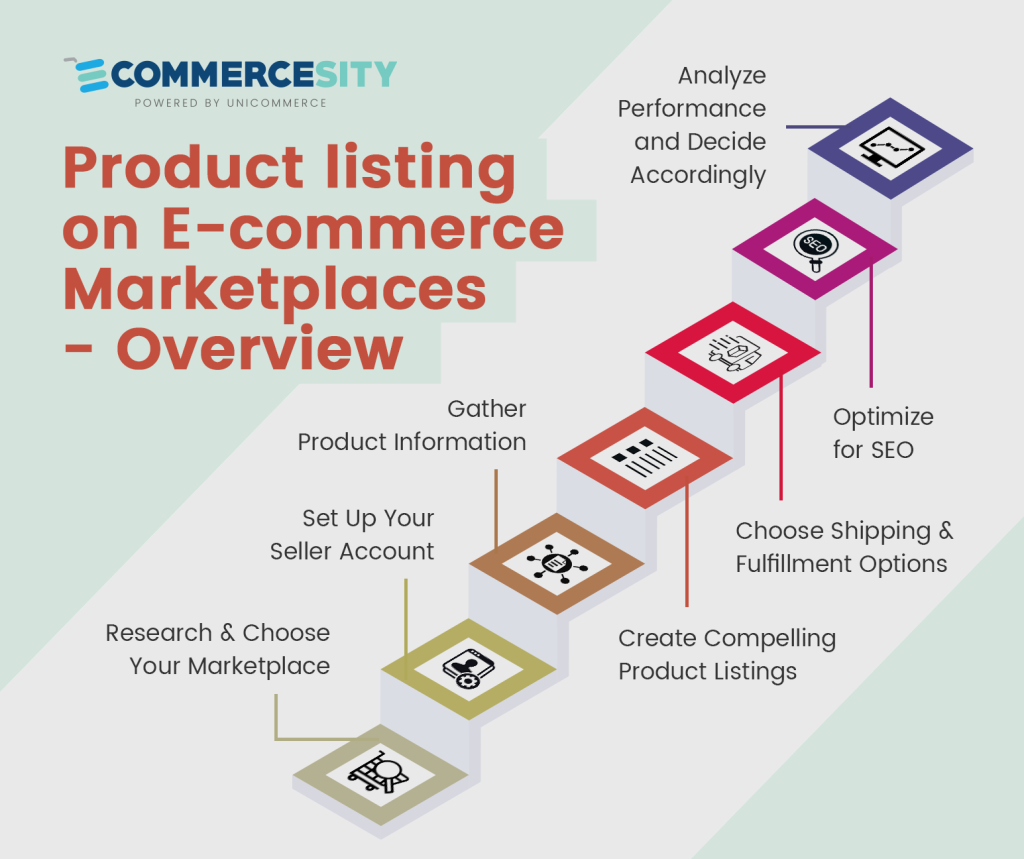It is a no-brainer that the world of retail has shifted significantly towards online platforms. The new emerging companies find their way to showcase themselves through some industry giants, namely Amazon, Myntra, Flipkart, Ajio, FirstCry, etc. These marketplaces are known for their dominance in e-commerce and have helped other brands grow exponentially.
Though these marketplaces have offered a helping hand to many brands and businesses, certain factors stop brands from listing their products on the mentioned marketplace. This guide will help you learn how to list products on these platforms, understand their significance, and explore how they can elevate your sales.
Why List Products on Marketplaces?
Before we understand how to list products on marketplaces, we need to know why they are required. Listing products on e-commerce platforms opens the floodgates to a vast online audience. It helps a brand meet its audience and their needs without any demographic limitations. It allows the brand to gain extensive visibility and access to larger customer bases.
Listing products on marketplaces helps reduce costs and facilitate faster business expansion. Marketplaces provide the seller with infrastructure, which makes it relatively easy for the seller to list products. It saves them from operational burdens and costs.
Marketplaces like Amazon, eBay, and Etsy boast millions of active shoppers, so sellers can use this to their benefit and showcase their products. These platforms uplift brands to increase their visibility and credibility. Customers have an inherent trust in these marketplaces, so they believe in the brands available on the platforms and buy products without having to think much.
How To List Products on E-commerce Marketplaces
We are well-versed in the importance of listing products on marketplaces, but we are still trying to figure out how to do so. Well, now we dive into the step-by-step guide to listing products.

Step 1: Research and Choose Your Marketplace
A seller needs to know the kind of brand they are creating and identify their target audience. The seller should act accordingly and find the right place in the marketplace. For example, If a brand sells kids’ products, enlisting themselves on Amazon and Flipkart can be a good choice. However, they should prioritize themselves on FirstCry as it is a marketplace solely dedicated to selling goods for children. Every brand must comply with the market’s certainties, which will help them have a better online presence.
Step 2: Set Up Your Seller Account
Once you choose your marketplace, you must set up a seller account. This would require some details about the seller and the products. Ensure you insert accurate information, such as banking details for payments.
Step 3: Gather Product Information
When you list your products, collect all the information, such as the product title, description, product code, high-resolution pictures, etc. Ensure your product information is accurate, detailed, and optimized for search engines to improve discoverability.
Step 4: Create Compelling Product Listings
An essential part of product listing is creating a compelling product listing. This includes high-resolution images, accurate and detailed descriptions, accurate pricing, and relevant keywords.
Step 5: Choose Shipping and Fulfillment Options
Choose the shipping and fulfillment methods that best suit your business needs. You can utilize the marketplace’s fulfillment services like Fulfillment by Amazon (FBA) or manage shipping independently.
Step 6: Optimize for SEO
Optimize your product listings for search engines by inserting relevant keywords, optimizing product titles, and utilizing backend search terms. This will help product visibility and optimize ranking on search result pages on marketplace platforms.
Step 7: Analyze Performance and Decide Accordingly
The pointers mentioned above are starters to listing products on marketplaces, and the process of listing new products will be similar. However, after listing products, one must analyze metrics such as sales, views, engagements, etc. This data can be used to improve and refine listings and marketing strategies to drive better results.
Now that we have understood why listing is important and how to list our products, we need to understand another crucial point: the functionalities involved in listing.
Functionalities of Product Listing
Listing products on marketplaces involves a streamlined process but should be done carefully. Some functionalities involved in product listing are:
1. Create Attractive Listings: To attract people to your products, you should insert compelling product descriptions, high-resolution images, accurate pricing, and relevant keywords.
2. A+ Listings: Certain platforms offer more than basic product listings. They provide extra features such as multimedia content, comparison charts, and detailed product descriptions to enhance the shopping experience.
3. Payments and Charges: Marketplaces demand certain charges for a seller; one should know them and understand them nicely while listing products and understand the fee structures and payment processes
Now that you know all about product listing, do you still need a helping hand? Well, Ecommercesity is a platform that will teach you all about product listing and more.
Master Product Listing with Ecommercesity!
Online learning platforms like Ecommercesity hold expertise in streamlining the product listing process. Our course module will help optimize product listings for maximum visibility and effectiveness.
From creating a seller’s account to listing products, understanding reconciliation, and many other details of e-commerce, Ecommercesity is the way to go!
Though listing products can be time-consuming, tools and services automate the process, saving time and effort. This will also help track performance, obtain customer feedback, and make informed decisions to drive sales and profitability. Ecommercesity will help you learn skills and tools that will make this tedious process easy.
At Ecommercesity, we offer comprehensive course modules that cover both e-commerce business excellence and operational efficiency, providing a holistic understanding of supply chain management. By enrolling in our courses, you’ll be able to elevate your skills and excel in the dynamic world of e-commerce. Take advantage of unlocking your full potential. Enroll today and take the first step towards success!
Top Courses in E-commerce Operational Excellence –

